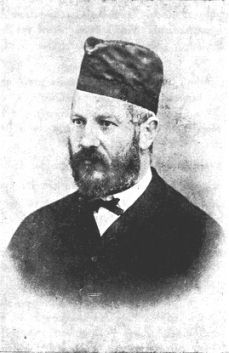
|
 |
He was an outstanding president of the Pápa community for decades.
He was a beloved student of R. Lipót Lőw, who served here between 1846-49. When Lőw was already in Szeged, they continued to correspond to each other in Hebrew for a long time. The great rabbi called him ba'al dikduk.
When Salamon Breuer, later the rabbi of Frankfurt, was in Pápa, Adolf Lőwenstein, at the time already holding the post of community president became a most devoted follower of this intransigent orthodox rabbi.
On one occasion the so-called enlightened members of the community achieved majority in a coup, so to say, and gave the rabbi notice. They were afraid that his strictly religious ideals would hinder the realization of their liberal ideas. Adolf Lőwenstein led a deputation to minister Trefort, who reinstated Rabbi Breuer in office, under the influence of Lőwenstein's convincing arguments. It was rightfully stated by Rabbi Breuer about Lőwenstein that the Pápa community president would measure up to the job in Paris as well!
He was an educated man and a strictly religious Jew. However, he wore boots and Hungarian attire. (Why not? If Polish chassids were allowed to wear the rabbit-skin headgear of Polish nobility, who would forbid the president of the Pápa community, breathing the very spirit of the Hungarian War of Independence, to wear Hungarian attire?)
His wife, the admired Rezl Lőwenstein, was a model for pious Jewish women (her grandmother Rochl Tevel founded the first Association of Jewish Women) practising the mitzvah of matan beseter: when a needy customer visited her flour shop she put the money back into the flour bag of the poor man.
In his last will, Adolf Lőwenstein donated a fund for feeding 10 Catholic, 10 Protestant and 10 Jewish destitutes on his Yahrzeit, on condition that after the meal the Jews would read out the whole Birkat hamazon from the book.
At his funeral, there were six hajdús [bailiffs – the translator] with drawn swords, accompanying his coffin.
He brought up his children in a cultured, strictly religious spirit. His son Jakab fulfilled the post of gabbai at the community for decades. One of his daughters married Dezső Korein, a committee member and a writer, the founder and the president of the National Shomrei Shabbat Association.
His daughter Janka married Vilmos Steiner, the descendent of a famous family in Gyömöre, who was the community president at Pápa for 20 years. His son-in-law Emil Gestettner headed the Pápa yeshiva.
His third daughter married Zsigmond Steiner, a highly respected wholesaler and she presided over the Hachnasat Kalah Association until her death. Head of the strictly religious family, Zsigmond Steiner, saved one-tenth of his income for charity. His surviving descendants still respectfully preserve his box for the maaser.
His memory is cherished in love and respect by his grandchildren: Sándor Lőwenstein (published several memoirs about life in Pápa), his sister Sári, Irma Steiner, the spouse of David Breuer, and László Korein, all of them living in Israel, and Emil Korein, living in South America.
And we, the Jews of Pápa, remember our famous rashekol with reverence and blessing.
befitting the rank of Pápa community presidents, served as such for 10 years.
For him it was not a post, the means of showing off; on the contrary, it meant an opportunity for him to notice concealed poverty and modest distress in the community, which he was appointed to lead by a consensus of general respect and unanimous love. He was a Jew in the Biblical sense; his pious religiousity was most profound. His father was the president of the Shiur Association for decades. He gave more than the compulsory maaser of his assets. Charity was the focal point of his life. His goodness was supported by a worthy helper in everything; his spouse, who was the younger sister of Dr. Samu Lasz, a Kolozsvár High School principal.
A great blow, the tragic loss of their only daughter together with their young grandchild, broke the parents' hearts and at the same time raised them to the height of human greatness. They saved other people from suffering, this was their only solace.
Everyone who knew him loved him.
It was formed simultaneously with the community in 1749. In the beginning they buried their dead at Német-Tevel, a small town nearby, which at that time was a fairly large community with a rabbi. Then they had burial plots inside the Roman Catholic cemetery in Pápa, at the Calvary. Later on land for burial plots was purchased to set up a cemetery at the end of Hosszú Utca (now Jókai Utca), so the Jews buried at the Calvary were disinterred and moved to the new cemetery. This explains the fact that we can find here tombstones older than the cemetery itself. Rabbi Horovitz and Rabbi Rapaport were buried here, as well as the the ancestors and other relatives of native Pápa Jews. The cemetery is also visited by those Jews who eventually moved far away from Pápa, for the purpose of fulfilling the mitzva of Kever Avot At Tisha Beav, after finishing the Kinoth at 11, Chevra Kadisha officials took the carriages waiting for them in front of the temple and came here in order to send their prayers to Heaven from the graves of the holy men.
The grandfather of “the Hungarian G. B. Shaw”, Frigyes Karinthy, is also found here, in this old cemetery: Mr. Kohn was a watchmaker and umbrella repairer, living in a humble flat in the courtyard of the Ókollégium [Old Protestant High School – Ed.].
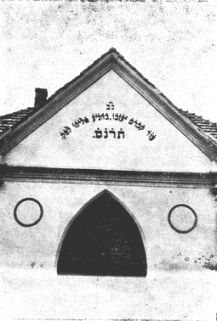 |
At the time of the great plague of Pápa (the history of which was recorded by Dr. Móric Feitel, the head physician of Pápa) two orphans got married at the cemetery under a chupa set up over a grave, in the presence of the whole community. Their story came down to us by word of mouth, unfortunately failing to record the name of the young couple, for the sake of historical accuracy. It used to be mentioned as a fact that after the wedding, the dangerous plague weakened and eventually stopped completely.
We must record with regret that the mortuary was sold by the National Bureau of Israelites (Orsz. Izr. Iroda) to a non-Jew, who demolished the building, which should have been considered a historic monument, and the valuable frescos were lost.
At the end of the 19th century the cemetery got filled up completely, so there was a need for new burial plots. Two Hungarian acres of land were purchased for the purpose of the cemetery not far from the old one, next to the Calvinist cemetery. The inscription over the mortuary expressed the hope of resurrection:
Maintainance of the cemetery set a difficult task for Chevra Kadisha officials. The problem of tombstone inscriptions triggered a nationwide dispute. The original Hebrew inscriptions were followed by German, later by Hungarian ones. Among rhymed epitaphs a special place is occupied by the ones in Hebrew, written by Reb Kive Schreiber, Reb Yosef-Leb Neumann, and Chevra secretary Stern, where by connecting the first letters of the lines read out the name of the deceased. On the tomb-stone of Dr. Iván Katona, who died young, and Dr. Lipót Koritschoner, Chief County Attorney, you can read their own poem:
October lights, you can go on flirting,
Frail human beings, we are to be pitied,
Whose lamenting souls, torn to bits and pieces,
Beg for solace the October lights.
You can also find here some epitaphs by the poet, Rabbi Dr. Arnold Kiss, the chief rabbi of Buda.
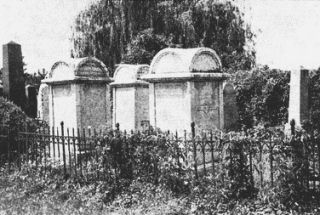 |
| Rabbinnical graves in the Pápa cemetery |
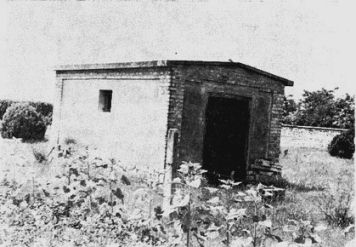 |
| Ohel over the grave of R. Yechezkiel Grünwald |
All the following persons were buried in this cemetery: Moshe Arye Róth, chief rabbi Sámuel Gottlieb, Moshe Link, dayan Zvi Eckstein, and R. Yechezkiel Grünwald, whose grave had been covered by an ohel, built by his followers. A separate monument marks the place of burial of the Torah scrolls desecrated by the Nazis.
At the entrance to the cemetery there is a notice board of Chevra officials, calling on family members of the dead to plant only green plants on the graves, not flowers…
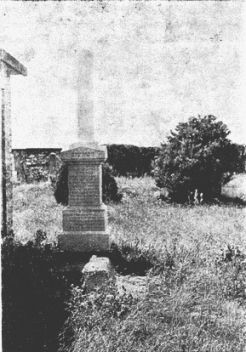 |
| A monument marks the place of burial of the Torah scrolls desecrated by the Nazis |
The Chevra Kadisha in the year of its foundation set up a Jewish hospital, preceding by nine years the hospital of the Brothers of Mercy. It was located in Ispotály (now Eötvös) utca, on the ground floor of the Chevra building; in two rooms there were beds for 4 male and 4 female patients. Later on the hospital was transferred to a building raised especially for this purpose in Korona Utca, where the number of patients was around 30-40. First “kórházas Róth” was the caretaker of the hospital [kórház means hospital in Hungarian], later on followed by “kórházas Schiffer”, whose wife was a true guardian angel for patients. Patients were treated by Pápa Jewish doctors free of charge. The Chevra Kadisha fulfilled their sacred task, and carried out the disposal of the dead according to strict rules. These minhagim should be recorded, as remembered by our friend, Sándor Lőwenstein:
On occasion of yetziat haneshama (departure of the soul) Binyamin Zev Baum visited Chevra officials, one by one, calling on each Yüd –Alef in Hebrew and German. If it happened at night, he humbly knocked at the window and reported the case. The book Mavor Yabok must always be at its appointed place so that they could find it easily in darkness as well. (This is a prayer book dealing with burial rituals, popularly called Mayver Yabok.) The dying person was first visited by a Chevra member to see if he was conscious. Then other members entered. They prayed from Mavor Yabok. Near the end of the agony, they lit a candle with a green end. The candles were distributed at the entrance of the temple, at Zayin Adar, and the officials received braided havdala candles. When the dying person asked for it, they recited together with him the “Viduy” confession..
Caring for the dead was called “mesasek sein“, (mitasek, caring for, in Hebrew). Only Chevra officials were allowed to participate in the preparation of the coffin; in exceptional cases male family members were also invited. At the tahara (the ritual washing of the dead) the president of the Chevra offered the honour to individual officials to participate in the washing. Before the burial, Mr. Breiner went around the town. He wore a lightweight black cape over his suit and a black top-hat with the letters ח”ק standing for Chevra Kadisha, holding a collecting box bearing the name of the dead and the time of the funeral. He knocked at each and every Jewish house, announcing “mes mitzvo“, and when the charity was dropped into the collecting box, he said good-bye with the words “tzedoko tatzil mimoves“, charity saves you from death. The burial took place at a prescribed time. The dead were carried on shoulders all the way to the cemetery. It was an honour, as demonstrated by the fact that those who committed suicide were taken on a wagon.. In front of the mortuary, they stopped three times, placing the coffin on the ground. From here, they carried the dead in their hands. They placed a sand-bag called Erdzekl, under the head of the dead. The bag was filled with sand with an upturned hand, and ground from Eretz Yisrael was added for the righteous. There was no board under the head of the barminan, the deceased. The first shovel of earth was thrown by the president of the Chevra, followed by the officials, then by the family. They took special care not to hand over the shovel; it had to be thrown down and picked up by the next in line. There was no chazan accompanying the procession, and no El Male Rachamim said during the burial. On the eyes and mouth of the deceased so called sharbelach were placed, while in his hand they put a two-pronged, fork-like branch, as a symbol of resurrection.
Breaking off the review of burial customs, let us insert a memoir by Gyula Láng in connection with the latter minhag:
Marcheshvan 28. Feelings of pain awaken in me. Six decades had passed since then, nevertheless the memory of the sad day stayed with me. I can see my father, a 52 year-old, fine figure of a man, cheerful, everybody's beloved Uncle Náci. In his free time he used his expertise in doing woodwork, using the fretsaw, drawing sketches. We turned to him with a mixture of awe and curiosity:
-Dad, what are you preparing?-You will find out in a couple of days.
A hidden tear was shining in his eye and he went on drawing letters. In a clandestine manner, the work was getting ready - no other Jews ever did the same, preparing like this. I know that others think of death as well, some buy their graves in advance, others get their funeral clothes ready. But you Dad, on the other hand, cut out with the saw yourself the gepelach and kneaded the clay for the sharbelach.
Our burial rite includes a simple, rough wooden coffin, white funeral clothes without pockets, a two-pronged, fork-like piece of wood to place in the hand of the deceased (called gepelach because it is like a fork), and shards (popularly called sharbelach) for the mouth and the eyes.
While he was cutting with the saw, drawing and creating, his hand and his vision were driven by the fever of his illness and his inspiration, his heartbeat was throbbing in the lifeless wood. He was contemplating death; it was painful for his soul to leave his spouse and four young children. His piety breathed the letters on the carved, smoothly polished forks:
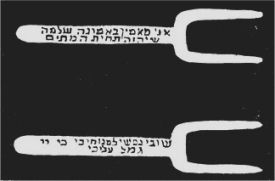 |
| “Two wooden forks for the time of the resurrection, to make it easier to rise to the last trumpet.” |
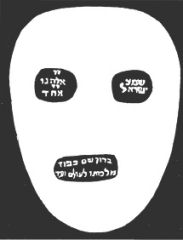 |
| “Clay on the eyes, what he saw, he shouldn't. Close his lips – the seal of silence” |
Only pure belief in God could radiate towards him the words that he drew on the other piece of wood:
I fully believe in the resurrection of the dead!
What self-control, artistic inspiration, holy feeling came over the man at the zenith of his life, kneading the clay, shaping it nice and round, and painting the holiest confession on the clay for closing the eye:
So that when the lips cannot move anymore to praise the glory of God, even then he would have the crop he had made himself over the lips, proclaiming: “Blessed is the Name of His glorious kingdom for all eternity”…
Let us return to funeral rituals. Eulogies were rarely given in Pápa; there were no burial chants or wreaths on the coffin. There were eulogies only for outstanding persons. However, when 90 year-old, bent uncle Marton toured the town with the collection box, he was reciting tzedoko tatzil mimoves in such a harrowing voice that it, in fact, substituted for the eulogy, because no eye stayed dry at the sound of the trembling words from the lips of the old man, tzedoko tatzil mimoves…
During the shivah, minyan was held at the mourners' house. If there was no minyan on Friday night, the mourner went to the temple and prayed in the hall until the Lecha dodi. After Boi Vshalom, the chazan turned back and said “likras ovel”, then the mourner passed along the benches and the community recited the usual consolation: “Hamokaym yenachem eschem”, May the Omnipresent comfort you among other mourners of Zion and Jerusalem. The rabbi or the dayan left his prayer-niche in order to approach the mourner…
The Chevra Kadisha organized its annual feast at Rosh Chodesh Nisan. This is how it was reported by Yeda Am, a folklore periodical published in Israel:
“First, the rabbi eulogized those who died during the year. In the Chevra room, a coffin was placed with a shovel and a rope used for burial next to it. Earlier they held the feast for the young, called the melachim – those serving at the the table were dressed as coffin bearers – who were obligated to drink wine that had been poured over a comb used at the tahara.
At night they had the feast for senior Chevra members in an intimate atmosphere, at the end of which they drank krampampuli, a very special kind of brandy that they were supposed to drink sitting on the floor, singing zmirot, religious songs...
After the Shoah, the holy activities of the Chevra came to an end. Bila hamavet lanetzach…There was no more Jewish life at Pápa, there was no more death either. Only the cemetery, the world of the dead proclaim that some time ago, maybe not so long ago, there had been such a prospering Jewish life here… No longer… It was finished…
|
JewishGen, Inc. makes no representations regarding the accuracy of
the translation. The reader may wish to refer to the original material
for verification.
JewishGen is not responsible for inaccuracies or omissions in the original work and cannot rewrite or edit the text to correct inaccuracies and/or omissions.
Our mission is to produce a translation of the original work and we cannot verify the accuracy of statements or alter facts cited.
 Pápa, Hungary
Pápa, Hungary
 Yizkor Book Project
Yizkor Book Project
 JewishGen Home Page
JewishGen Home Page
Copyright © 1999-2024 by JewishGen, Inc.
Updated 4 Sep 2009 by LA